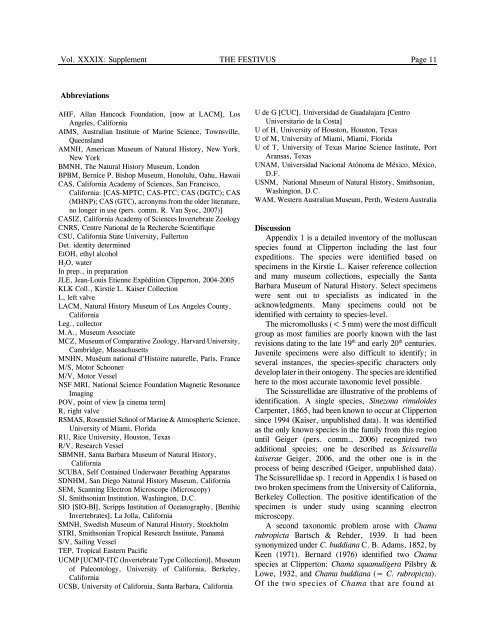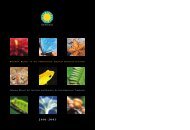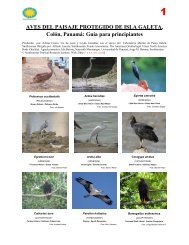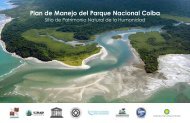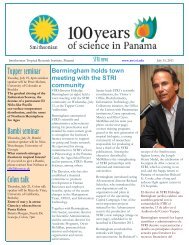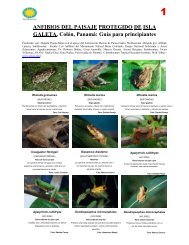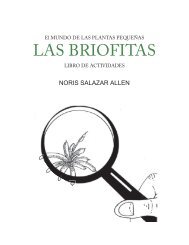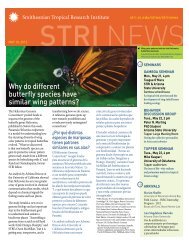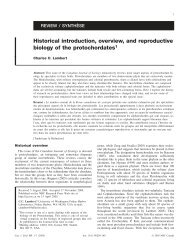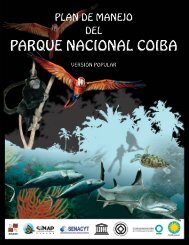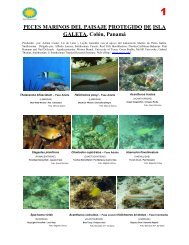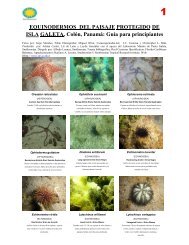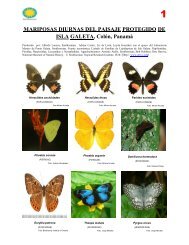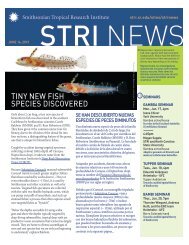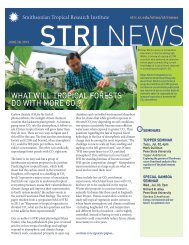Download - Smithsonian Tropical Research Institute - Smithsonian ...
Download - Smithsonian Tropical Research Institute - Smithsonian ...
Download - Smithsonian Tropical Research Institute - Smithsonian ...
You also want an ePaper? Increase the reach of your titles
YUMPU automatically turns print PDFs into web optimized ePapers that Google loves.
Vol. XXXIX: Supplement THE FESTIVUS Page 11<br />
Abbreviations<br />
AHF, Allan Hancock Foundation, [now at LACM], Los<br />
Angeles, California<br />
AIMS, Australian <strong>Institute</strong> of Marine Science, Townsville,<br />
Queensland<br />
AMNH, American Museum of Natural History, New York,<br />
New York<br />
BMNH, The Natural History Museum, London<br />
BPBM, Bernice P. Bishop Museum, Honolulu, Oahu, Hawaii<br />
CAS, California Academy of Sciences, San Francisco,<br />
California: [CAS-MPTC; CAS-PTC; CAS (DGTC); CAS<br />
(MHNP); CAS (GTC), acronyms from the older literature,<br />
no longer in use (pers. comm. R. Van Syoc, 2007)]<br />
CASIZ, California Academy of Sciences Invertebrate Zoology<br />
CNRS, Centre National de la Recherche Scientifique<br />
CSU, California State University, Fullerton<br />
Det. identity determined<br />
EtOH, ethyl alcohol<br />
H 2O, water<br />
In prep., in preparation<br />
JLE, Jean-Louis Etienne Expédition Clipperton, 2004-2005<br />
KLK Coll., Kirstie L. Kaiser Collection<br />
L, left valve<br />
LACM, Natural History Museum of Los Angeles County,<br />
California<br />
Leg., collector<br />
M.A., Museum Associate<br />
MCZ, Museum of Comparative Zoology, Harvard University,<br />
Cambridge, Massachusetts<br />
MNHN, Muséum national d’Histoire naturelle, Paris, France<br />
M/S, Motor Schooner<br />
M/V, Motor Vessel<br />
NSF MRI, National Science Foundation Magnetic Resonance<br />
Imaging<br />
POV, point of view [a cinema term]<br />
R, right valve<br />
RSMAS, Rosenstiel School of Marine & Atmospheric Science,<br />
University of Miami, Florida<br />
RU, Rice University, Houston, Texas<br />
R/V, <strong>Research</strong> Vessel<br />
SBMNH, Santa Barbara Museum of Natural History,<br />
California<br />
SCUBA, Self Contained Underwater Breathing Apparatus<br />
SDNHM, San Diego Natural History Museum, California<br />
SEM, Scanning Electron Microscope (Microscopy)<br />
SI, <strong>Smithsonian</strong> Institution, Washington, D.C.<br />
SIO [SIO-BI], Scripps Institution of Oceanography, [Benthic<br />
Invertebrates], La Jolla, California<br />
SMNH, Swedish Museum of Natural History, Stockholm<br />
STRI, <strong>Smithsonian</strong> <strong>Tropical</strong> <strong>Research</strong> <strong>Institute</strong>, Panamá<br />
S/V, Sailing Vessel<br />
TEP, <strong>Tropical</strong> Eastern Pacific<br />
UCMP [UCMP-ITC (Invertebrate Type Collection)], Museum<br />
of Paleontology, University of California, Berkeley,<br />
California<br />
UCSB, University of California, Santa Barbara, California<br />
U de G [CUC], Universidad de Guadalajara [Centro<br />
Universitario de la Costa]<br />
U of H, University of Houston, Houston, Texas<br />
U of M, University of Miami, Miami, Florida<br />
U of T, University of Texas Marine Science <strong>Institute</strong>, Port<br />
Aransas, Texas<br />
UNAM, Universidad Nacional Atónoma de México, México,<br />
D.F.<br />
USNM, National Museum of Natural History, <strong>Smithsonian</strong>,<br />
Washington, D.C.<br />
WAM, Western Australian Museum, Perth, Western Australia<br />
Discussion<br />
Appendix 1 is a detailed inventory of the molluscan<br />
species found at Clipperton including the last four<br />
expeditions. The species were identified based on<br />
specimens in the Kirstie L. Kaiser reference collection<br />
and many museum collections, especially the Santa<br />
Barbara Museum of Natural History. Select specimens<br />
were sent out to specialists as indicated in the<br />
acknowledgments. Many specimens could not be<br />
identified with certainty to species-level.<br />
The micromollusks (< 5 mm) were the most difficult<br />
group as most families are poorly known with the last<br />
revisions dating to the late 19 th and early 20 th centuries.<br />
Juvenile specimens were also difficult to identify; in<br />
several instances, the species-specific characters only<br />
develop later in their ontogeny. The species are identified<br />
here to the most accurate taxonomic level possible.<br />
The Scissurellidae are illustrative of the problems of<br />
identification. A single species, Sinezona rimuloides<br />
Carpenter, 1865, had been known to occur at Clipperton<br />
since 1994 (Kaiser, unpublished data). It was identified<br />
as the only known species in the family from this region<br />
until Geiger (pers. comm., 2006) recognized two<br />
additional species; one he described as Scissurella<br />
kaiserae Geiger, 2006, and the other one is in the<br />
process of being described (Geiger, unpublished data).<br />
The Scissurellidae sp. 1 record in Appendix 1 is based on<br />
two broken specimens from the University of California,<br />
Berkeley Collection. The positive identification of the<br />
specimen is under study using scanning electron<br />
microscopy.<br />
A second taxonomic problem arose with Chama<br />
rubropicta Bartsch & Rehder, 1939. It had been<br />
synonymized under C. buddiana C. B. Adams, 1852, by<br />
Keen (1971). Bernard (1976) identified two Chama<br />
species at Clipperton: Chama squamuligera Pilsbry &<br />
Lowe, 1932, and Chama buddiana (= C. rubropicta).<br />
Of the two species of Chama that are found at


